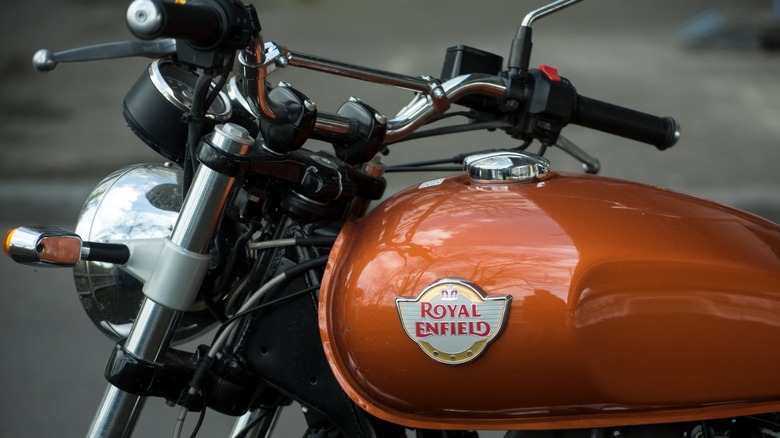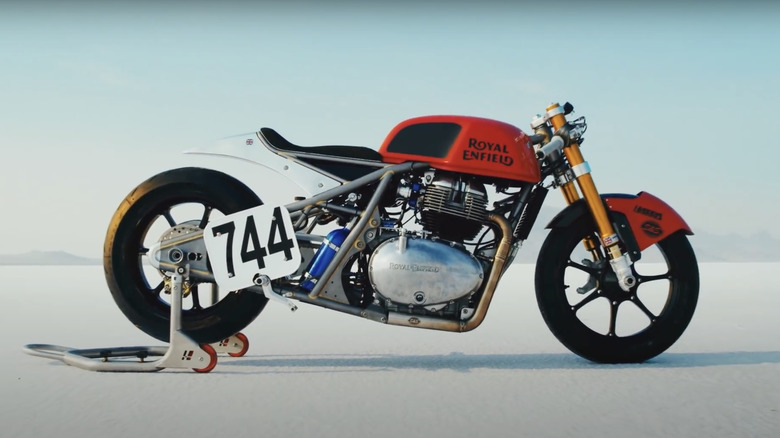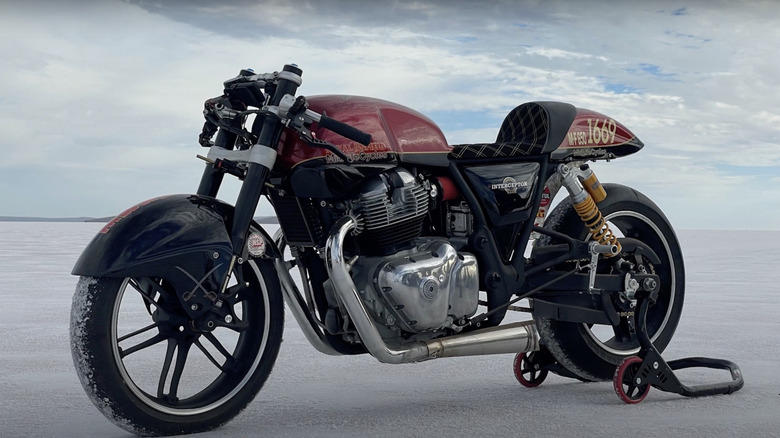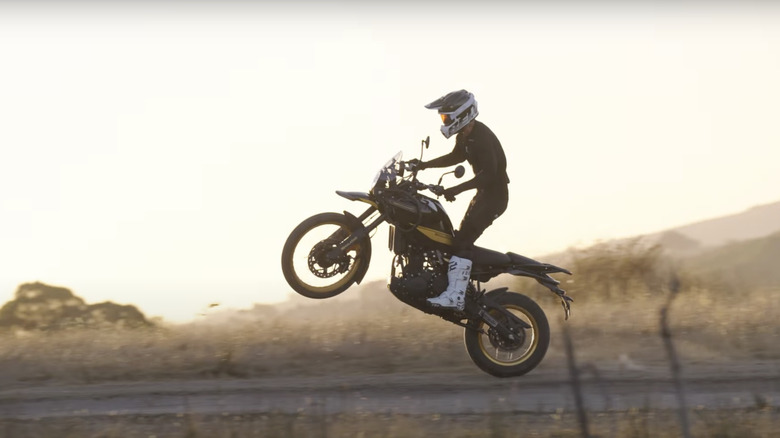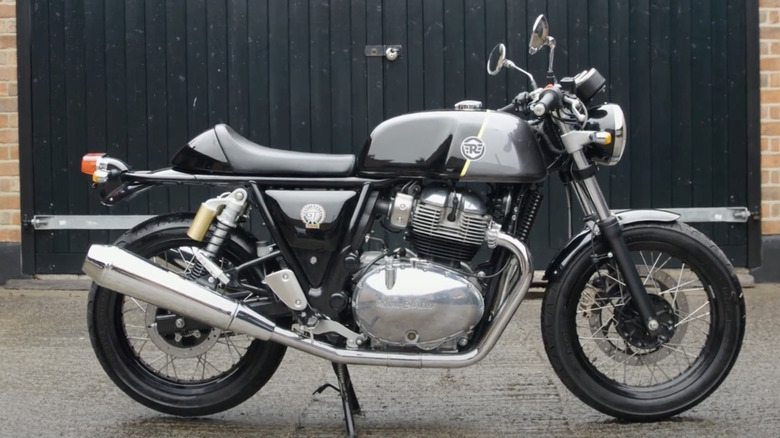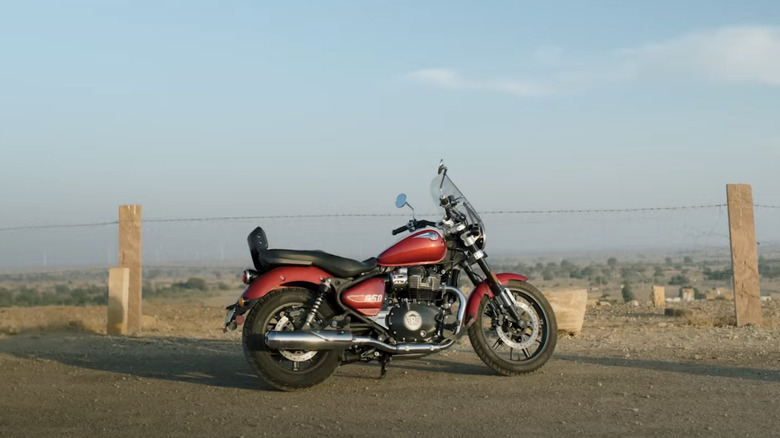5 Of The Fastest Motorcycles Royal Enfield Ever Built
Royal Enfield might not be the first name that comes to mind when you think about speed. But when it comes to building simple, reliable, and affordable motorcycles, this brand checks all three boxes. And if that doesn't impress you, maybe the fact that it's the world's oldest motorcycle brand still in production will.
Although the company started out making bicycles, it pivoted to motorcycles in the early 1900s, eventually producing one of the most important bikes of World War II. Royal Enfield would go on to create some more remarkable bikes. However, the rise of Japanese manufacturers in the '60s and '70s proved to be too much competition, not just for Enfield, but for most British motorcycle brands. By 1970, Enfield's U.K. operations had shut down.
Production continued in India, where the company focused almost exclusively on single-cylinder models for the next few decades. But that trajectory changed when Eicher Motors acquired Royal Enfield and later brought Harris Performance, a British racing chassis specialist, in-house. Since then, the brand has been pushing the envelope in terms of speed and performance. In 2017, it moved beyond the classic 350/500cc singles and developed a new 650cc parallel-twin engine. As a result, we're now getting a new generation of faster, better-performing bikes. Let's take a look at some of them.
Royal Enfield Bonneville Racer
This is a one-off custom speed bike that started with a simple question: how fast can a Royal Enfield go without the usual limits of production requirements? And what better place to find out than the racing competition at the Bonneville Salt Flats? Now, mind you, racing at Bonneville is no joke. The salt is unpredictable and slippery. And the altitude, which is over 4,200 feet above sea level, means lower air pressure, which messes with both engine performance and aerodynamics.
So, the team got to work on the Continental GT 535, which was RE's sportiest production bike at the time. The single-cylinder 535cc engine, which made about 29 horsepower in stock form, was upgraded with a bigger head, new camshafts, and an updated fuel injection system. But even with the extra work, the bike only managed to hit 97 mph. Then, in 2018, when Royal Enfield introduced its new 650cc parallel-twin platform, the project finally had the muscle it needed. The team worked with S&S Cycle to squeeze maximum performance out of the engine. While the stock version made 47 horsepower, the race-tuned version, with higher compression, heavy head work, and a nitrous oxide system, was able to deliver more than three times that.
The Harris Performance team, which designed Grand Prix and superbike frames before joining the company, also lent their expertise. They reworked the chassis completely, from the suspension geometry to the wheelbase, so the bike could stay stable at straight-line speed. When 18-year-old racer Cayla Rivas took the wheel at the race, the bike hit a two-way average of 157.053 mph, smashing the previous class record by almost 60 mph.
Royal Enfield Interceptor 650 Sabre Salt Racer
Royal Enfield entered into another speed competition in 2021. This time, it was Australia's annual Speed Week on the salt flats of Lake Gairdner. For this one, they decided to bring on the storied Interceptor. The first Interceptor, based on a tuned 692cc vertical twin, had made its debut back in the 1960s. It had garnered a reputation for being particularly impressive. And by the '70s, the displacement had jumped to 750cc. However, when the competition from Japanese manufacturers forced Royal Enfield to end its U.K. operations, the Interceptor disappeared from the lineup.
Six decades later, in 2018, the company brought the Interceptor back as a 650cc road bike capable of hitting a top speed of around 100 mph. It quickly became one of the best motorcycles from Royal Enfield and one of the best-sounding bikes ever. But for Speed Week, Royal Enfield's goal was to take the modern Interceptor 650, strip it down, build it up, and show just how far the 648cc twin could really go. To do it right, they teamed up with Australian custom builders Mid Life Cycles, HRA Geelong, and Hallam Cycle Works.
Together, they created the Interceptor "Sabre" Salt Racer. While they didn't change the displacement, almost everything else was reworked. The engine got forged high-compression pistons, a ported cylinder head, a performance camshaft, and a reprogrammed throttle body tuned to run on 98-octane fuel. The gearing was adjusted, the swingarm stretched to the class limit, and the suspension upgraded with full Öhlins hardware. When first-time salt racer Charlie Hallam took it out on the flats, the Sabre clocked in a new official class record of 132.050 mph, with a top run of 133.779 mph.
Royal Enfield Himalayan 450
Moving on from salt flats and competitions, Royal Enfield continued redesigning some of its core models. One of the most significant upgrades came in 2023, when the 411cc Himalayan was replaced by the Himalayan 450, introducing the company's first fully liquid-cooled engine. The new 452cc DOHC single-cylinder engine, nicknamed "Sherpa," produces around 40 horsepower and 30 lb-ft of torque, which is nearly double the output of the original Himalayan 411.
That new engine was matched with an all-new chassis from Harris Performance. The frame is now a twin-spar design, paired with long-travel Showa suspension and a 21-inch front wheel. On paper, it reads like a solid ADV setup. But more importantly, riders agree that it holds steady across a range of terrains. On pavement, the Himalayan 450 is especially comfortable between 55 and 85 mph, holding its own in tall sixth gear. Off-road, it's still nimble and flexible, with a low-ish adjustable seat height (32.5 to 33.3 inches) and a wet weight of about 196 kilograms.
This bike also received major tech updates. The Himalayan 450 comes with a ride-by-wire throttle, two riding modes, and switchable rear ABS, which are all firsts for Royal Enfield. It also received a 4-inch circular TFT display, which now supports full Google Maps navigation. Unlike the older model, which barely pushed past 75 mph and reportedly struggled even downhill, this version feels relaxed well into the '80s and can reach 90 mph at full stretch. Even though the Himalayan 450 isn't quite a hardcore rally machine, it's pretty rugged. And for the price, one could say it's made adventure touring on a quality bike more accessible.
Royal Enfield Continental GT 650
Just like the Interceptor 650 brought back a beloved name from the 1960s, the Continental GT 650 is a modern reboot of another classic — the Continental GT 250. That original model was one of the first café racers sold in the U.K. and quickly became a hit, especially among young people learning how to ride. When Royal Enfield revived the GT name back in 2014 with an upgraded 535cc single, it was designed to capture that old-school charm.
Since then, Royal Enfield has continued to transform the bike even further. Now, it shares the same 648cc parallel twin-cylinder SOHC engine as the Interceptor. However, everything else about it is sportier. You get a narrower 12.5-liter tank, clip-on handlebars mounted just above the triple clamp, rearset footpegs, and a solo café-style seat. The frame, developed with Harris Performance, is a twin-downtube cradle setup, with ByBre brakes and a visibly low-slung stance that leans all the way into its neo-retro identity.
The 18-inch wheels, firm suspension, and relatively short wheelbase give it a responsive, planted feel, even on bumpy roads. It's also lower and more focused than the Interceptor, which means the ergonomics are not as comfortable. At highway speeds, however, it comfortably cruises at over 70 to 80 mph and can stretch all the way to a top speed of 105 mph, depending on the road and rider.
Royal Enfield Super Meteor 650
This is Royal Enfield's first proper cruiser built on the 648cc twin platform, but the name itself isn't new. The original Super Meteor dates back to 1955 and was the company's first motorcycle capable of hitting 100 mph. In 2023, with input from the U.K. Technology Centre at Bruntingthorpe and the Harris Performance team, Royal Enfield brought the name back with a bike that feels both modern and deeply familiar. At its core is the same 648cc air/oil-cooled parallel-twin you'll find in the Interceptor and Continental GT, but with revised intake and exhaust systems tuned for cruising. It's paired with a six-speed gearbox and slip-assist clutch. Thanks to its 270-degree firing order, the engine delivers a torquey ride with the kind of character you'd expect from a 90-degree V-twin engine.
While most riders agree that the Super Meteor is most content somewhere around 60 to 70 mph, others have confirmed that you can push it as far as 90 mph. Nonetheless, Royal Enfield claims the top speed is 120 mph, which is pretty ambitious for a middleweight cruiser. And speaking of weight, despite weighing 241 kilograms wet, it doesn't feel unwieldy. Its low center of gravity, 19-inch front and 16-inch rear alloy wheels, and wide 150-section rear tire all contribute to giving it that grounded character. It's relatively comfortable for most, though shorter riders, especially anyone under 5 foot 5 inches, might find it a bit of a stretch.
On the one hand, these bikes are proof that Royal Enfield has recently made a lot of progress in terms of speed and performance. On the other hand, it's evident that the brand remains committed to its long-standing ethos of building bikes that are simple, authentic, and worth every bit of what you pay.
